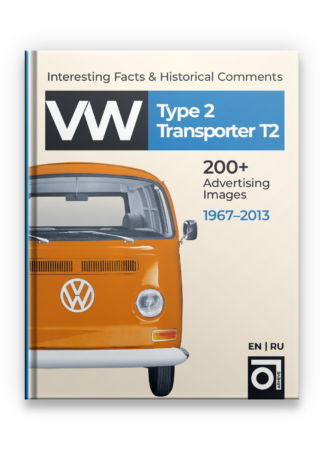Описание
VW Transporter T2 (Type 2) Hardcover book (fragment of text)
Debuting in the summer of 1967, the second generation of the Transporter opened a new era in the model’s history.
The T2 became the brand’s most common commercial vehicle – its production continued until the end of 2013! Over 46 years, 4.8 million cars were produced in different countries with a variety of modifications.
When Dutch Volkswagen dealer Ben Pon drew a sketch of a light delivery van in 1947 and showed it to company boss Heinrich Nordhoff, no one could have imagined what a phenomenal success it would become just a few years later.
Having received the management’s approval, Volkswagen engineers and designers began to implement the idea, and at the end of 1949, the first Type 2 commercial vans were produced, the first generation of the Transporter (T1).
By 1967, the attractive vehicle was offered as a van, pickup, ambulance, passenger van, and camper, and as various specialized cargo and cargo-passenger modifications.
Since the design of the Type 2 used components and assemblies of the related VW Beetle, it was a reliable and inexpensive car to maintain.
In addition, by the mid-1960s, Volkswagen had established a wide network of service stations and arranged for timely delivery of spare parts to anywhere in the world where its products were represented.
The new vehicle — the second generation Type 2 – was presented in the summer of 1967. The vehicle had a new body design without the characteristic V-shaped notch, like the T1, and a large panoramic windshield with an air intake grille under it.
Chassis design changes included an upgraded front suspension, requiring less maintenance, and a wishbone rear suspension.
As standard, the T2 got a sliding side door, which significantly facilitated access to the interior in cramped parking lots. Travel enthusiasts had at their disposal a superb Westfalia camper with a retractable roof and a full set of furnishings and vacation accessories.
The engine power increased from 47 hp in 1968 to 70 hp by the end of the 1970s, and an automatic transmission appeared for the first time in the list of options as an alternative to manual. According to the press release, this made the “new Volkswagen Transporter like a passenger car.”
Volkswagen achieved record sales in the early 1970s. Exports to North and South America also grew. While the pace of annual T2 sales in the U.S. increased to more than 70,000, the Brazilian subsidiary announced a record annual production of 66,280 vehicles for the domestic market.
By 1979, when the new T3 generation replaced the T2, more than 3.1 million second-generation Transporters had been manufactured worldwide. However, the change of generations did not mean the end of the model; production continued at factories in South America and South Africa.
The VW factory in Sao Paulo holds the record for the longest production run: the final 1,200 of the T2 56 Anos Kombi Last Edition rolled off the Volkswagen do Brasil assembly line in autumn 2013, and the total run exceeded 4.8 million vehicles!
In the summer of 1967, Volkswagen introduced the second generation Transporter. The car was larger than its predecessor, had more glazing, a sliding side door, and an improved chassis with a new rear suspension.
At the same time, the car remained compact enough and did not exceed the dimensions of a classic sedan or station wagon of those years.
The opposing engine was positioned lower to increase the cargo space above the engine compartment. The T2 was also 160 mm longer than the previous model. As a result, the cargo compartment behind the front seats grew to 5 m3.
Read the continuation of VW Transporter T2 (Type 2) story in the book.
Other books about history of Volkswagen:

















Отзывы
Отзывов пока нет.